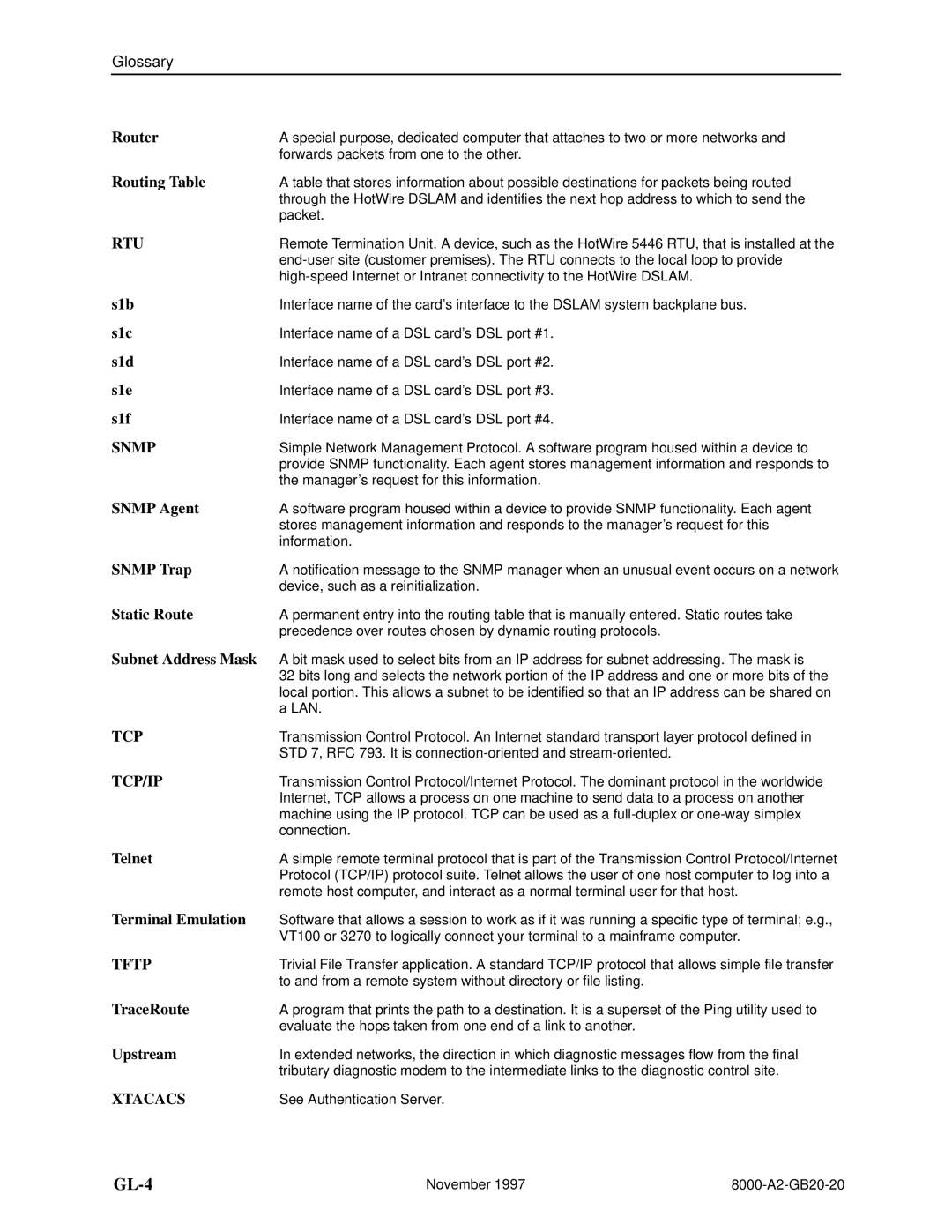Glossary
Router | A special purpose, dedicated computer that attaches to two or more networks and |
| forwards packets from one to the other. |
Routing Table | A table that stores information about possible destinations for packets being routed |
| through the HotWire DSLAM and identifies the next hop address to which to send the |
| packet. |
RTU | Remote Termination Unit. A device, such as the HotWire 5446 RTU, that is installed at the |
| |
| |
s1b | Interface name of the card's interface to the DSLAM system backplane bus. |
s1c | Interface name of a DSL card's DSL port #1. |
s1d | Interface name of a DSL card's DSL port #2. |
s1e | Interface name of a DSL card's DSL port #3. |
s1f | Interface name of a DSL card's DSL port #4. |
SNMP | Simple Network Management Protocol. A software program housed within a device to |
| provide SNMP functionality. Each agent stores management information and responds to |
| the manager's request for this information. |
SNMP Agent | A software program housed within a device to provide SNMP functionality. Each agent |
| stores management information and responds to the manager's request for this |
| information. |
SNMP Trap | A notification message to the SNMP manager when an unusual event occurs on a network |
| device, such as a reinitialization. |
Static Route | A permanent entry into the routing table that is manually entered. Static routes take |
| precedence over routes chosen by dynamic routing protocols. |
Subnet Address Mask | A bit mask used to select bits from an IP address for subnet addressing. The mask is |
| 32 bits long and selects the network portion of the IP address and one or more bits of the |
| local portion. This allows a subnet to be identified so that an IP address can be shared on |
| a LAN. |
TCP | Transmission Control Protocol. An Internet standard transport layer protocol defined in |
| STD 7, RFC 793. It is |
TCP/IP | Transmission Control Protocol/Internet Protocol. The dominant protocol in the worldwide |
| Internet, TCP allows a process on one machine to send data to a process on another |
| machine using the IP protocol. TCP can be used as a |
| connection. |
Telnet | A simple remote terminal protocol that is part of the Transmission Control Protocol/Internet |
| Protocol (TCP/IP) protocol suite. Telnet allows the user of one host computer to log into a |
| remote host computer, and interact as a normal terminal user for that host. |
Terminal Emulation | Software that allows a session to work as if it was running a specific type of terminal; e.g., |
| VT100 or 3270 to logically connect your terminal to a mainframe computer. |
TFTP | Trivial File Transfer application. A standard TCP/IP protocol that allows simple file transfer |
| to and from a remote system without directory or file listing. |
TraceRoute | A program that prints the path to a destination. It is a superset of the Ping utility used to |
| evaluate the hops taken from one end of a link to another. |
Upstream | In extended networks, the direction in which diagnostic messages flow from the final |
| tributary diagnostic modem to the intermediate links to the diagnostic control site. |
XTACACS | See Authentication Server. |
November 1997 |
